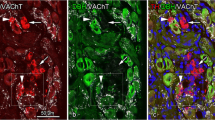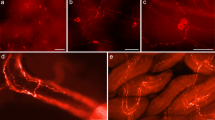Abstract
The present immunocytochemical study provides evidence of a previously unrecognized, rich, γ-aminobutyric acid (GABA)-ergic innervation of the pineal organ in the dogfish (Scyliorhinus canicula). In this elasmobranch, the pineal primordium is initially detected at embryonic stage 24 and grows to form a long pineal tube by stage 28. Glutamic acid decarboxylase (GAD)-immunoreactive (-ir) fibers were first observed at stage 26, and by stage 28, thin GAD-ir fibers were detectable at the base of the pineal neuroepithelium. In pre-hatchling embryos, most fibers gave rise to GAD-ir boutons that were localized in the basal region of the neuroepithelium, although a smaller number of labeled terminals ascended to the pineal lumen. A few pale GAD-ir perikarya were observed within the pineal organ of stage 29 embryos, but GAD-ir perikarya were not observed at other developing stages or in adults. In contrast, GABA immunocytochemistry revealed the presence of GABAergic perikarya and fibers in the pineal organ of late stage embryos and adults. Although high densities of GABAergic cells were observed in the paracommissural pretectum, posterior tubercle, and tegmentum of dogfish embryos (regions previously demonstrated to contain pinealopetal cells), the presence of GABA-ir perikarya in the pineal organ strongly suggests that the rich GABAergic innervation of the elasmobranch pineal organ is intrinsic. This contrasts with the central origin of GABAergic fibers in the pineal gland of some mammals.




Similar content being viewed by others
References
Anadón R, Molist P, Rodríguez-Moldes I, López JM, Quintela I, Cerviño MC, Barja P, González A (2000) Distribution of choline acetyltransferase (ChAT) immunoreactivity in the brain of an elasmobranch, the lesser spotted dogfish (Scyliorhinus canicula). J Comp Neurol 420:139–170
Ballard WW, Mellinger J, Lechenault H (1993) A series on normal stages for development of Scyliorhinus canicula, the lesser-spotted dogfish (Chondrichthyes: Scyliorhinidae). J Exp Zool 267:318–336
Brandstätter R, Hermann A (1996) γ-Aminobutyric acid enhances the light response of ganglion cells in the trout pineal organ. Neurosci Lett 210:173–176
Dkhissi O, Julien JF, Wasowicz M, Dalil-Thiney N, Nguyen-Legros J, Versaux-Botteri C (2001) Differential expression of GAD(65) and GAD(67) during the development of the rat retina. Brain Res 919:242–249
Ekström P (1987) Photoreceptors and CSF-contacting neurons in the pineal organ of a teleost fish have direct axonal connections with the brain: an HRP-electron-microscopic study. J Neurosci 7:987–995
Ekström P, Korf H-W (1985) Pineal neurons projecting to the brain of the rainbow trout, Salmo gairdneri Richardson (Teleostei). In vitro retrograde filling with horseradish peroxidase. Cell Tissue Res 240: 693–700
Ekström P, Ohlin L-M (1995) Ontogeny of GABA-immunoreactive neurons in the central nervous system in a teleost, Gasterosteus aculeatus L. J Chem Neuroanat 9:271–288
Ekström P, van Veen T (1984) Pineal neural connections with the brain in two teleosts, the Crucian carp and the European eel. J Pineal Res 1:245–261
Ekström P, van Veen T, Bruun A, Ehinger B (1987) GABA-immunoreactive neurons in the photosensory pineal organ of the rainbow trout: two distinct neuronal populations. Cell Tissue Res 250:87–92
Ekström P, Honkanen T, Ebbesson SO (1988) FMRFamide-like immunoreactive neurons of the nervus terminalis of teleosts innervate both retina and pineal organ. Brain Res 460:68–75
Ekström P, Östholm T, Meissl H, Bruun A, Richards JG, Møller H (1990) Neural elements in the pineal complex of the frog, Rana esculenta. II. GABA-immunoreactive neurons and FMRFamide-immunoreactive efferent axons. Vis Neurosci 4:399–412
Feldblum S, Dumoulin A, Anoal M, Sandillon F, Privat A (1995) Comparative distribution of GAD65 and GAD67 mRNAs and proteins in the rat spinal cord supports a differential regulation of these two glutamate decarboxylases in vivo. J Neurosci Res 42:742–757
Fenwick JC (1970) Demonstration and effect of melatonin in fish. Gen Comp Endocrinol 14:86–97
Gruber SH, Hamasaki DI, Davis BL (1975) Window to the epiphysis in sharks. Copeia 2:378–380
Hafeez MA, Zerihun L (1974) Studies on central projections of the pineal nerve in rainbow trout, Salmo gairdneri Richardson, using cobalt chloride iontophoresis. Cell Tissue Res 154:485–510
Hamasaki DI, Streck P (1971) Properties of the epiphysis cerebri of the small-spotted dogfish shark, Scyliorhinus caniculus L. Vision Res 11:189–198
Hardwick C, French SJ, Southam E, Totterdell S (2005) A comparison of possible markers for chandelier cartridges in rat medial prefrontal cortex and hippocampus. Brain Res 1031:238–244
Holmgren N (1918) Zum Bau der Epiphyse von Squalus acanthias. Ark Zool 11:1–28
Holstein GR, Martinelli GP, Henderson SC, Friedrich VL Jr, Rabbitt RD, Highstein SM (2004) Gamma-aminobutyric acid is present in a spatially discrete subpopulation of hair cells in the crista ampullaris of the toadfish Opsanus tau. J Comp Neurol 471:1–10
Jiménez AJ, Fernández-Llébrez P, Pérez-Fígares JM (1995) Central projections from the goldfish pineal organ traced by HRP-immunocytochemistry. Histol Histopathol 10:847–852
Katarova Z, Sekerkova G, Prodan S, Mugnaini E, Szabo G (2000) Domain-restricted expression of two glutamic acid decarboxylase genes in midgestation mouse embryos. J Comp Neurol 424:607–627
Korf HW, Wagner U (1980) Evidence for a nervous connection between the brain and the pineal organ in the guinea pig. Cell Tissue Res 209:505–510
Krishna NS, Subhedar NK (1992) Distribution of FMRFamide-like immunoreactivity in the forebrain of the catfish, Clarias batrachus (Linn.). Peptides 13:183–191
Maler L, Mugnaini E (1994) Correlating gamma-aminobutyric acidergic circuits and sensory function in the electrosensory lateral line lobe of a gymnotiform fish. J Comp Neurol 345:224–252
Mandado M, Molist P, Anadón R, Yáñez J (2001) A DiI-tracing study of the neural connections of the pineal organ in two elasmobranchs (Scyliorhinus canicula and Raja montagui) suggests a pineal projection to the midbrain GnRH-immunoreactive nucleus. Cell Tissue Res 303:391–401
Meiniel A (1981) New aspects of phylogenetic evolution of sensory cell lines in the vertebrate pineal complex. In: Oksche A, Pévet P (eds) The pineal organ: photobiology—biochronometry—endocrinology, Elsevier/North Holland, Amsterdam, pp 27–47
Meissl H, Dodt E (1981) Comparative physiology of pineal photoreceptor organs. In: Oksche A, Pévet P (eds) The pineal organ: photobiology—biochronometry—endocrinology. Elsevier/North-Holland, Amsterdam, pp 61–80
Meissl H, Ekström P (1991) Action of gamma-aminobutyric acid (GABA) in the isolated photosensory pineal organ. Brain Res 562:71–78
Meissl H, Yáñez J (1996) Diazepam increases melatonin secretion of photosensitive pineal organs of trout in the photopic and mesopic range of illumination. Neurosci Lett 207:37–40
Meléndez-Ferro M, Pérez-Costas E, Villar-Cheda B, Abalo XM, Rodríguez-Muñoz R, Anadón R, Rodicio MC (2002a) Ontogeny of γ-aminobutyric acid-immunoreactive neuronal populations in the forebrain and midbrain of the sea lamprey. J Comp Neurol 446:360–376
Meléndez-Ferro M, Pérez-Costas E, Villar-Cheda B, Abalo XM, Rodríguez-Muñoz R, DeGrip WJ, Yáñez J, Rodicio MC, Anadón R (2002b) Early development of the retina and pineal complex in the sea lamprey: comparative immunocytochemical study. J Comp Neurol 442:250–265
Møller M, Baeres FMM (2002) The anatomy and innervation of the mammalian pineal gland. Cell Tissue Res 309:139–150
Møller M, Korf HW (1983) The origin of central pinealopetal nerve fibers in the Mongolian gerbil as demonstrated by the retrograde transport of horseradish peroxidase. Cell Tissue Res 230:273–287
Møller M, Korf HW (1987) Neural connections between the brain and the pineal gland of the golden hamster (Mesocricetus auratus). Tracer studies by use of horseradish peroxidase in vivo and in vitro. Cell Tissue Res 247:145–153
Mugnaini E, Maler L (1987) Cytology and immunocytochemistry of the nucleus exterolateralis anterior of the mormyrid brain: possible role of GABAergic synapses in temporal analysis. Anat Embryol 176:313–336
Mugnaini E, Wouterlood FG, Dahl AL, Oertel WH (1984) Immunocytochemical identification of GABAergic neurons in the main olfactory bulb of the rat. Arch Ital Biol 122:83–113
Nürnberger F, Korf HW (1981) Oxytocin- and vasopressin-immunoreactive nerve fibers in the pineal gland of the hedgehog, Erinaceus europaeus L. Cell Tissue Res 220:87–97
Pombal MA, Yáñez J, Marín O, González A, Anadón R (1999) Cholinergic and GABAergic neuronal elements in the pineal organ of lampreys, and tract-tracing observations of differential connections of pinealofugal neurons. Cell Tissue Res 295:215–223
Rüdeberg C (1968) Receptor cells in the pineal organ of the dogfish, Scyliorhinus canicula (L.). Z Zellforsch 85:521–526
Rüdeberg C (1969) Light and electron microscopic studies on the pineal organ of the dogfish, Scyliorhinus canicula (L.). Z Zellforsch 96:548–581
Sakai Y, Hira Y, Matsushima S (2001) Central GABAergic innervation of the mammalian pineal gland: a light and electron microscopic immunocytochemical investigation in rodent and nonrodent species. J Comp Neurol 430:72–84
Soghomonian JJ, Martin DL (1998) Two isoforms of glutamate decarboxylase: why? Trends Pharmacol Sci 19:500–505
Studnička FK (1905) Die Parietalorgane. In: Oppel A (ed) Lehrbuch der vergleichenden mikroskopischen Anatomie der Wirbeltiere, Bd V. Fischer, Jena, pp 1–254
Sueiro C (2003) Estudio inmunohistoquímico de los sistemas gabaérgicos del sistema nervioso central de peces elasmobranquios y su relación con los sistemas catecolaminérgicos y peptidérgicos. PhD Thesis, University of Santiago de Compostela
Sueiro C, Carrera I, Molist P, Rodriguez-Moldes I, Anadón R (2004) Distribution and development of glutamic acid decarboxylase immunoreactivity in the spinal cord of the dogfish Scyliorhinus canicula (elasmobranchs). J Comp Neurol 478:189–206
Ueck M (1979) Innervation of the vertebrate pineal. In: Ariëns Kappers J, Pévet P (eds) The pineal gland of vertebrates. Elsevier/North-Holland, Amsterdam, pp 45–88
Vigh-Teichmann I, Vigh B (1992) Immunocytochemistry and calcium cytochemistry of the mammalian pineal organ: a comparison with retina and submammalian pineal organs. Microsc Res Tech 21:227–241
Vigh-Teichmann I, Vigh B, Manzano e Silva MJ, Aros B (1983) The pineal organ of Raja clavata: opsin immunoreactivity and ultrastructure. Cell Tissue Res 228:139–148
Vigh-Teichmann I, Petter H, Vigh B (1991) GABA-immunoreactive intrinsic and -immunonegative secondary neurons in the cat pineal organ. J Pineal Res 10:18–29
Wilson JF, Dodd JM (1973) The role of the pineal complex and lateral eyes in the colour change response of the dogfish, Scyliorhinus canicula. J Endocrinol 58:591–598
Yáñez J, Anadón R (1998) Neural connections of the pineal organ in the primitive bony fish Acipenser baeri: a carbocyanine dye tract-tracing study. J Comp Neurol 398:151–161
Yáñez J, Anadón R, Holmqvist BI, Ekström P (1993) Neural projections of the pineal organ in the larval sea lamprey (Petromyzon marinus L.) revealed by indocarbocyanine dye tracing. Neurosci Lett 164:213–216
Yáñez J, Pombal MA, Anadón R (1999) Afferent and efferent connections of the parapineal organ in lamprey: a tract tracing and immunocytochemical study. J Comp Neurol 403:171–189
Acknowledgements
We thank Dr. Fátima Gil (Aquario “Vasco da Gama”, Lisbon, Portugal), Joaô Correia (Oceanário, Lisbon), and Alfredo Veiga (Aquarium Finisterrae, A Coruña, Spain) for providing the dogfish embryos and juveniles used in this study, and Quico Cruces and fishermen of the “Quico IV” for providing the adult dogfish specimens. We also thank Dr. Enrico Mugnaini (Department of Cell and Molecular Biology, Northwestern University Medical School) for the gift of the sheep anti-GAD antibody used in this study.
Author information
Authors and Affiliations
Corresponding author
Additional information
This work was supported by the Spanish Education and Science Ministry and FEDER (BXX2000-0453-C02 and BFU2004-03313/BF1), the Xunta de Galicia (PGIDT99BIO20002), and NIH/NIDCD awards R01 DC01705 and P01 DC01837 (to G.R.H.).
Rights and permissions
About this article
Cite this article
Carrera, I., Sueiro, C., Molist, P. et al. GABAergic system of the pineal organ of an elasmobranch (Scyliorhinus canicula): a developmental immunocytochemical study. Cell Tissue Res 323, 273–281 (2006). https://doi.org/10.1007/s00441-005-0061-8
Received:
Accepted:
Published:
Issue Date:
DOI: https://doi.org/10.1007/s00441-005-0061-8




